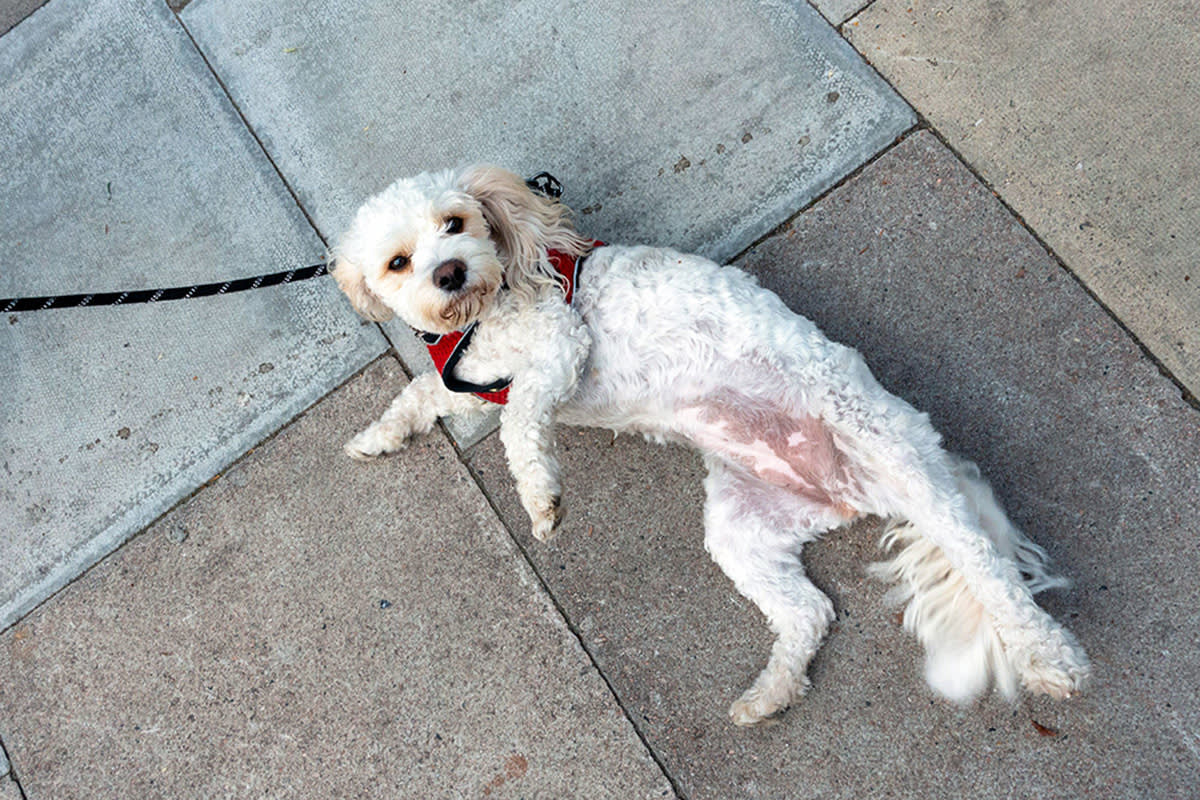Do Dogs Throw Temper Tantrums?
They’re definitely not happy when they don’t get their way.
Blue the Siberian Husky has been wronged, and he will not calm down until his blanket has been returned to him, thank you very much. He does not care that his dog sibling peed on it and that it is now being washed — he wants his blanket, and he wants it now.
His parents filmed his little meltdowopens in new tab n, and commenters weighed in: Dogs “really are just toddlers with fur.”
Trick question: All dogs are perfect! But find out which type is the best fit for you.
And if social media is to be believed, Blue’s not the only one in “temper tantrum” mode. This German Shepherdopens in new tab is fighting a great injustice: the fact that he might not get a pup cup today. This Pomeranianopens in new tab is livid that her person deigns to leave their apartment. This Doodleopens in new tab literally gives his mom the side eye when she tries to wipe his paws (rude). And this Siberian Huskyopens in new tab — oh wait, it’s Blue again — is absolutely letting his dad have it over his new bed even though it’s kind of… fabulous? And this Dachshundopens in new tab might just be having the cutest little protest ever, with his paw stomps and sassy kicks.
But what’s really going on with all these pups?
How much do you spend on your pet per year?
“Dogs are not dramatic as a species — they are simply using their behavior to communicate their needs and emotions with us,” says Dr. Kristin Kuntzopens in new tab, a board-certified veterinary behaviorist at Insight Animal Behavior Servicesopens in new tab in Chicago. “It is important for pet parents to have a good understanding of dog body language to understand what they are trying to say and how we can set them up for success.”
But is that behavior considered an actual temper tantrum — and do dogs know what they’re doing?
Do dogs really throw temper tantrums?
It turns out the word tantrum isn’t really the best way to describe what’s happening when our dogs get a little fussy.
“Dogs can show a subset of behaviors that can resemble a temper tantrum,” says Tatiana Yastremskiopens in new tab, a certified dog trainer and behavior consultant at St. Hubert’s Animal Welfare Centeropens in new tab in Madison, New Jersey. She adds that a human tantrum can be more intentional. Yastremski notes that she prefers to call these canine behaviors “reactions.”
Dr. Kuntz agrees that the term tantrum isn’t quite right.
“While dogs can experience heightened states of emotion and physical stimulation, veterinary professionals do not typically refer to these behaviors as ‘tantrums,’ as that implies a certain level of cognitive and social understanding that we can attribute to people but not to dogs,” Dr. Kuntz says. “The label of ‘tantrum’ also does not tell us why the dog is behaving the way they are, as there can be many potential underlying causes for this type of behavior.” However, that’s not to say that our dogs don’t protest when something is wrong in their world.
In pups, a tantrum, so to speak, might look like:�
Jumping
Pawing
Scratching
Muzzle punching (when a dog bumps you with their nose)
Stopping and not moving forward
Lunging
Lying down
Turning over on their backs
Dogs having a so-called tantrum may also display physiological signs of stress, like panting, dilated pupils, tense muscles, licking their lips, and yawning, Dr. Kuntz says.
Of course, these signs listed above are not necessarily indicative of a tantrum on their own, but if they’re unusual for your dog, they may be signs your dog is displeased. “Each behavior displayed by a dog has a purpose,” Yastremski says. “That’s why it is important for a dog parent to figure out what purpose a certain set of behaviors serves.”
These behaviors may be repetitive, or they may be one-offs.
“I will never forget a Lab I saw for a vet visit,” says Dr. Andrew Findlaytoropens in new tab, a veterinarian and editorial advisory board member at dvm360. “At first the dog was all cuddled and happy. Then after I gave the dog vaccines… the dog looked at the [pet parent], walked to the other end of the room, and just stared with sad, crabby eyes for the rest of the visit. It was the closest I have ever come to seeing a dog say, ‘How dare you.’”
Even after some minutes had passed, the dog refused to budge. “Fortunately, some Easy Cheese was found and we were able to mend the relationship,” Dr. Findlaytor says.
Why do dogs have these little moments?
One reason it’s not fair to call them tantrums is because your dog isn’t necessarily being disobedient, like a mischievous kid might; they’re communicating in the best way they know how.
Plus, not all dogs get upset for the same reasons, Yastremski says. In fact, there are a handful of reasons your dog might be acting out. Dr. Kuntz breaks down the main reasons why your dog may appear to be throwing a tantrum:
Your dog is frustrated: They want something they cannot have (such as a toy or pup cup).
Your dog is bored: Their physical, social, or mental needs are not being met (for example, they’re feeling cooped up because they haven’t gone on enough walks).
Your dog is using learned behaviors to get attention: If you’ve given them attention in the past after they’ve had a little fit, they may be using whines, pawing, barking, or destructive behaviors to get attention from you again.
Fear or anxiety: Your dog is simply terrified or anxious because of a noise, sound, animal or person, or your absence, and they’re trying to communicate their emotional discomfort.
Pain or illness: While your pup’s symptoms might seem like a tantrum, your dog could actually be trying to let you know they’re physically unwell. “A dog who is not feeling well may be more anxious, more irritable, and more restless,” Dr. Kuntz says.
What’s important to remember is that this is your dog’s way of trying to communicate — and it’s a pet parent’s job to try to decode what’s happening.
“A dog who is frustrated, bored, seeking attention, stressed, or uncomfortable will use their behavior and body language to communicate those feelings and needs with their family,” Dr. Kuntz says. “When we see these body language changes and behaviors, it is important to think about what has occurred that day and what is going on in the environment at that time — essentially, what could have triggered this behavior to happen?”
Are tantrums normal?
Tantrums, or whatever you want to call a dog’s upset behavior, can be totally normal, experts say, but it’s important to pay attention to frequency. “If a dog is accustomed to a certain amount of exercise and does not get its usual amount of activity that day, it could be normal for the dog to communicate its boredom or frustration with its pet parents later that evening,” Dr. Kuntz says.
This could be the case, too, with a dog who is upset they didn’t get a pup cup: They’re used to getting one at the drive-thru and now wondering why they’re not. But often, these emotional outbursts are not so clear-cut, and they can be repeated behavior that needs to be assessed.
“If a dog is consistently reacting to a specific situation or stimulus with these behaviors, that is a sign that something more is going on that should be further investigated with the help of their veterinarian,” Dr. Kuntz explains. “For example, if the dog always reacts to being separated from its pet parents with heightened emotions and excessive movements, that may be a sign of separation anxiety. Or if a dog always reacts this way to the sound of a thunderclap or firework, that could be a sign of noise phobia.”
Yastremski, who lived with a leash-reactive dog, witnessed what may have looked like tantrums with her pup on walks — but she explains why they really can’t be classified this way at all: “This was my dog expressing fear and stress in the presence of other dogs while walking on leash,” she notes. Now, as a trainer, she helps pet parents in the same boat get their dogs through leash reactivity so that they no longer react negatively, no more tantrums.
How are tantrums treated?
Because this behavior is normal, it’s common for trainers and behaviorists to see this behavior on the regular. Dr. Kuntz notes that she generally sees good outcomes using a combination of different therapies, including:
Educating the dog’s family on canine body language
Managing the dog’s environment to avoid triggers
Providing adequate enrichment
Using positive reinforcement (for example, rewarding good behavior with treats)
Using other behavior modificationopens in new tab to teach desirable behaviors
Giving calming supplements or anti-anxiety medications (when prescribed by a veterinarian or veterinary behaviorist)
“Additionally,” she notes, “if a dog is consistently using these behaviors to seek attention from their family, the pet parent should work on providing their dog with a consistent daily routine with increased opportunities for enrichment and should interact with their dog in a predictable manner using positive reinforcement training.”
How can you help a pup who’s having big feelings?
In the moment, many pet parents can find it frustrating to deal with a dog who is seemingly losing their mind — often for a reason we’re not privy to. But our response says everything. “It is important to think about how we respond to this behavior, as our response can make the behavior more likely to happen again in the future,” Dr. Kuntz says.
Whatever your dog’s expression of emotion may look like, if it’s a regular occurrence, start by trying to figure it out and get to the source of the problem. If you can’t figure out what’s going on, see a vet to rule out any physical issues, then head to a certified trainer, behaviorist, or veterinary behaviorist.
Remember that positive reinforcement is always the way to go: Even when your dog is being a bit difficult, you need to keep things optimistic to avoid creating more fear and anxiety.
“In the moment, it is helpful to calmly bring the dog to a safe, quiet place to decompress,” Dr. Kuntz says. “Avoid too much interaction until the dog is calm in order to avoid inadvertently rewarding the behavior. Avoid using punishment in response to the behavior (or ever), because it can create fear and anxiety in the long-term and does not actually teach the dog what to do instead.”
Then you’ll need to dive into your dog’s symptoms within the context of the situation to find out what’s causing the behavior. If your dog is acting like this because of fear or stress, you might need to figure out if you’re going to avoid that trigger altogether — maybe that means avoiding the dog park or hunkering down inside when there are celebrations with fireworks. Or modify the trigger so it doesn’t cause the same degree of reaction.
If your dog appears to be kind of freaking out due to “frustration, boredom, or attention-seeking,” you need to create a consistent daily routine that “proactively meets the dog’s needs for social, physical, and mental enrichment,” Dr. Kuntz says. Either way, certified trainers, behaviorists, or veterinary behaviorists who practice positive reinforcement can help.
Bottom line: The worst thing you can do is nothing, Yastremski says. “Trust me, I know from my own experience they don’t grow out of it.”




